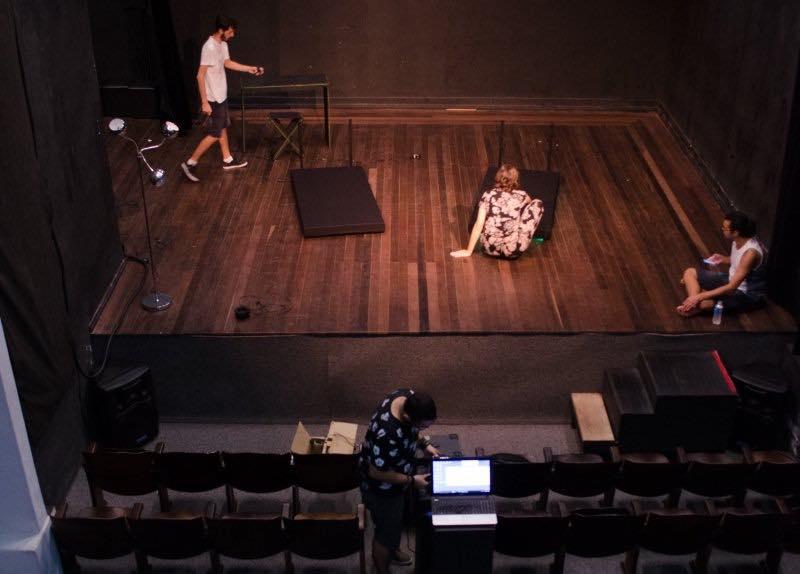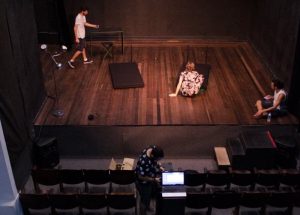If you’ve ever been in a play or musical you will be familiar with the term ‘stage directions’. For those who don’t know, stage directions are, “an instruction in the text of a play, especially one indicating the movement, position, or tone of an actor.” Stage directions can also be instructions for the director, such as the way the stage should be lit or what kind of sound effect could be used. Stage directions can also tell an actor how to deliver a line— pace of speech, emotion, tone of voice can all be put in the stage directions.
Let’s back it up, though.
What are stage directions?
UPSTAGE
DOWNSTAGE
STAGE RIGHT
STAGE LEFT
CENTER STAGE
To new actors, who don’t have much experience onstage, these terms can be confusing! It helps to remember that stage directions are given from the perspective of an actor who is looking at the audience, also known as the ‘house’ in a theater. So, for example, stage right and stage left mean the actor’s right and left, not the audience’s. Center stage is pretty self explanatory— it is the exact center point of the stage. It is usually marked with tape and very easy to find.
The other main stage direction terms are upstage and downstage. Upstage refers to the entire section of the stage farthest away from the audience, and downstage refers to the area closest to audience.
For the teachers reading this article, I like to play a game with my younger students called “Director Says”. It is a simple and easy way to get little actors accustomed to stage directions and familiar with being onstage. The game is essentially a version of Simon Says, except we use stage directions for the commands. For example, “Director says take three skips upstage left”. The students love it! It helps them become acquainted to basic stage directions quickly and in a fun and creative way.
To save time, sometimes directors and writers will use abbreviations for their stage directions. You can find the most common abbreviations below.
DS: Downstage
US: Upstage
USR: Upstage Right
DSR: Downstage Right
USL: Upstage Left
USR: Upstage Right
CS: Center Stage
DRC: Downstage right-center
DLC: Downstage left-center
RC: Right center
LC: Left center
URC: Upstage right-center
ULC: Upstage left-center
Fun fact: Stage directions aren’t simply words we came up with to explain where to go onstage. They actually were developed in the Middle Ages! In the Middle Ages stages were built on an upward incline away from the audience to improve viewer visibility. We now call this a ‘raked’ stage. “Upstage” appropriately meant the section of the stage that was higher, while “downstage” was the lower area.
Whether you’re an actor, writer, director or part of the stage crew, having a solid understanding of stage directions will absolutely help you to improve your craft. It is best to keep stage directions minimalistic and easy to interpret. This also leaves room for the director and actor to make bold choices of their own, while still honoring the original directions given.
Remember, Stage Directions Aren’t Commands
It is also important to remember that stage directions, while important, are directions and not commands. Just because a direction is written in the play does not necessarily mean it needs to be followed for your specific production. Perhaps the playwright had a large stage in mind when they were writing and you are using a black box theater for your show. Here, it is important to acknowledge the stage directions given and then make the best choice for your space and situation.
Your Actions Have to Come from a Deeper Place
Finally, it is important to understand that stage directions are so much more than simply telling an actor where and when to walk, stand, sit etc. There is a lot of work the actor and direction must do to dig deep and figure out motivation for these movements. Why does the character decide to move at that very moment? Odds are, the playwright had a clear reason for having their character choose that moment to change locations. It is up to you, the actor, to figure out the why.
When Stage Directions Tell the Story
Of course, some plays are known for their very specific theatre stage directions. For instance, esteemed playwright, Tennessee Williams is known for using stage directions to help tell the story. His stage directions are very, very important to note for both the actor and creative team, developing the world of the play. For instance, in William’s famous work, “The Glass Menagerie” he writes, “The scene is memory and is therefore non-realistic. Memory takes a lot of poetic license. It omits some details; others are exaggerated, according to the emotional value of the articles it touches, for memory is seated predominantly in the heart. The interior is therefore rather dim and poetic.” Yes, this is also a stage direction!
As you can see, stage directions are so much more than telling the actor where to stand and when to move. They can help shape a play and give the director and actor a jumping off point when developing characters and imaginary worlds. It is important to recognize the importance of stage directions when reading and performing in a play. Next time you’re working on a play, consider the reasons why certain stage directions are there. It will give you a deeper understanding of the work and help you hone your craft in a more meaningful way.
Emily Meredith

